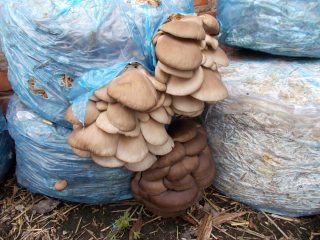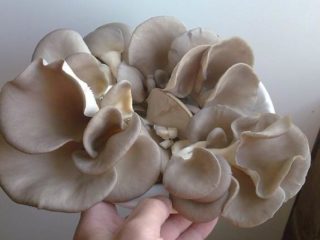Content
The Veshenkov family is numerous. There are more than a hundred varieties, but only about 10 main species are known and well studied. Oyster mushroom (Pleurotus calyptratus) is one of them. It is also called single or sheathed.
Where does oyster mushroom grow?
This variety is not found very often. It grows not in groups, but singly:
- in the north and central regions of Europe;
- in the north of our country;
- on the territory of Western Siberia.
Listed in the Red Book of the Krasnoyarsk Territory and Novosibirsk Region. Grows in mixed and coniferous forests on dead wood, aspen or fir.It appears en masse in early spring, at the same time as morels and strings. Throughout the summer it rarely bears fruit, which is why it is rarely found.

Single oyster mushroom on aspen wood
What does a covered oyster mushroom look like?
The fruiting body of the oyster mushroom consists of a cap, which can reach a diameter of up to 15 cm. The mushroom acquired its name thanks to the velum - a blanket that protects young bodies, which is not typical for other species. But as the mushroom grows, it gets rid of the film. It remains partially, in the form of patches on the lower surface, covered with yellowish plates arranged in a fan, freely and not so often. The geminophores produce whitish, colorless spores.
The outer surface of the fruiting body is dense, smooth, brown or gray in color. Sometimes the radial lead-colored fibers are clearly visible in the sun. The edges of the adult fruiting body are folded downwards. Under the sun it takes on a white tint. The mushroom looks like a small hoof, tightly seated on the surface of a dry tree. There are no legs, although in other species there are barely noticeable legs in the form of small stumps.

Remains of a blanket at the bottom of a covered oyster mushroom
Is it possible to eat covered oyster mushrooms?
This species belongs to the 4th class of edibility. But the covered oyster mushroom is considered inedible or conditionally edible due to the rubbery consistency of the pulp, although some mushroom pickers collect it and eat it boiled or fried. There are lovers of raw mushrooms. This is dangerous: without heat treatment they can lead to poisoning.
Taste qualities of mushroom
The smell of the variety resembles the aroma of raw potatoes. The taste is weak.
Similar species
It is very difficult to confuse the covered oyster mushroom with other species, since it grows mainly in May, earlier than other varieties of this family. Its distinctive feature is also the remains of velum covering the spore-bearing layer of young fruiting bodies located on the plates. Similar to this variety is the oak oyster mushroom, which also stands out as pieces of torn spathe, grows en masse on oak trees and is found in the summer. It has a stalk, so it is difficult to confuse it with the covered oyster mushroom.
Collection rules
May is the best time to collect covered oyster mushrooms. The caps of the fruiting bodies are carefully cut off with a knife, leaving the bases. It is recommended to collect young mushrooms. Their flesh is not so tough and the taste is more pleasant.
Use
The Veshenkov family, according to mycologists, has a rich composition. They saturate the human body with energy resources, essential vitamins, and contain useful mineral salts of calcium, potassium, iron, copper and other trace elements. Based on the variety of useful components, this fruiting body is often compared to fish.
In folk medicine, it is used to lower blood sugar levels and in the treatment of vascular diseases. Individual elements are used for neurological disorders. All these properties of the varieties of the Veshenkov family explain the cultivation of this fruiting body on an industrial scale in Europe and Russia. Their mycelia, including single species, are sold in special stores. Oyster mushrooms are the most unpretentious mushrooms. They can even be grown at home.
But you should not abuse food that contains these fruiting bodies.Children, pregnant women, the elderly and those who are intolerant to mushrooms need to be careful when consuming dishes made from them.
Conclusion
Oyster mushroom is a saprophyte. She, like many other fruiting bodies, plays the role of a forest orderly. Thanks to it, the process of rotting and decomposition of wood occurs faster. It is of practically no culinary interest, but if properly prepared it can become an interesting dish and does not pose a risk to human health.









